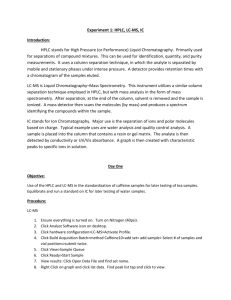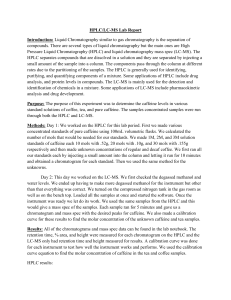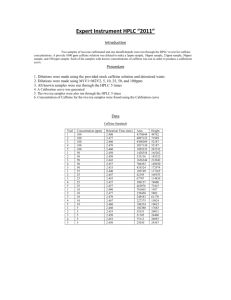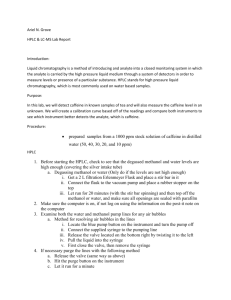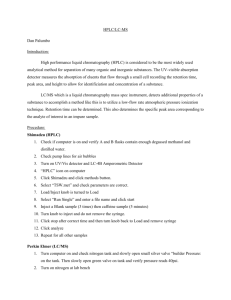HPLC and LC/MS
advertisement
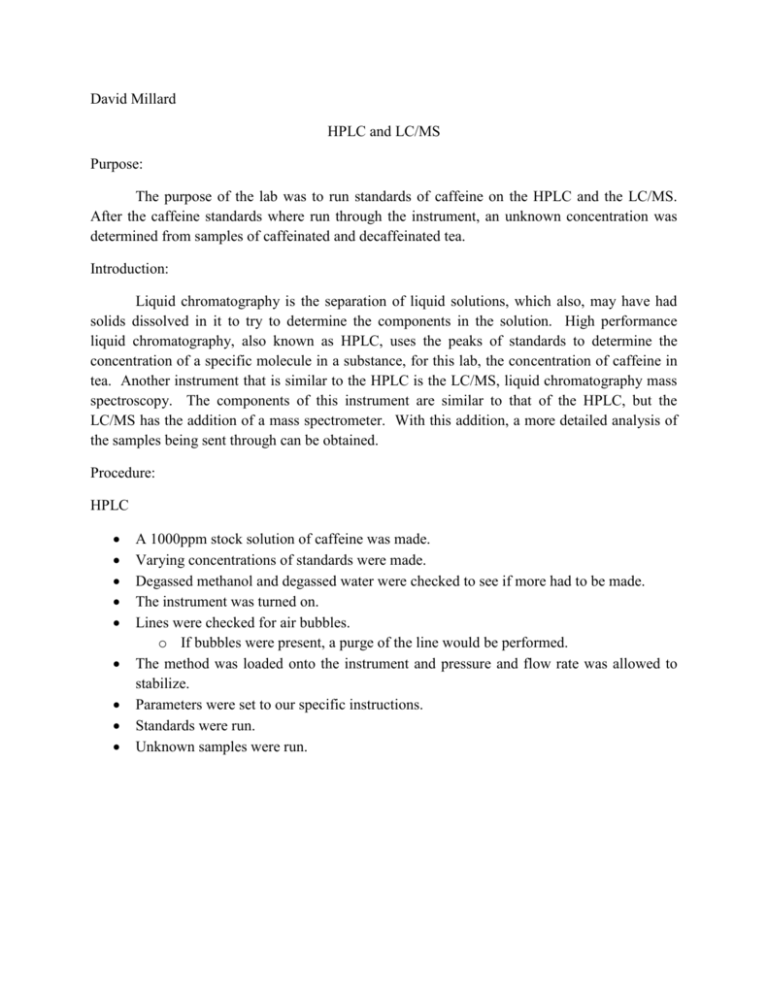
David Millard HPLC and LC/MS Purpose: The purpose of the lab was to run standards of caffeine on the HPLC and the LC/MS. After the caffeine standards where run through the instrument, an unknown concentration was determined from samples of caffeinated and decaffeinated tea. Introduction: Liquid chromatography is the separation of liquid solutions, which also, may have had solids dissolved in it to try to determine the components in the solution. High performance liquid chromatography, also known as HPLC, uses the peaks of standards to determine the concentration of a specific molecule in a substance, for this lab, the concentration of caffeine in tea. Another instrument that is similar to the HPLC is the LC/MS, liquid chromatography mass spectroscopy. The components of this instrument are similar to that of the HPLC, but the LC/MS has the addition of a mass spectrometer. With this addition, a more detailed analysis of the samples being sent through can be obtained. Procedure: HPLC A 1000ppm stock solution of caffeine was made. Varying concentrations of standards were made. Degassed methanol and degassed water were checked to see if more had to be made. The instrument was turned on. Lines were checked for air bubbles. o If bubbles were present, a purge of the line would be performed. The method was loaded onto the instrument and pressure and flow rate was allowed to stabilize. Parameters were set to our specific instructions. Standards were run. Unknown samples were run. Data: The LC/MS was down during our instrumentation period. The standards for the HPLC were made by diluting a 1000ppm solution of caffeine to 10, 20, 40, 60, 80, 100, 150, 200, and 300ppm. + 714250 Calibration CurveHPLC y = 31355x R² = 0.99 12000000 10000000 Area 8000000 6000000 4000000 2000000 0 0 50 100 150 200 Concentration (ppm) Dilution Calculations (1000ppm)(V1)=(10mL)(10ppm) V1= 0.1mL (1000ppm)(V1)=(10mL)(20ppm) V1= 0.2mL (1000ppm)(V1)=(10mL)(40ppm) V1= 0.4mL (1000ppm)(V1)=(10mL)(60ppm) V1= 0.6mL (1000ppm)(V1)=(10mL)(80ppm) V1= 0.8mL (1000ppm)(V1)=(10mL)(100ppm) V1= 1.0mL 250 300 350 (1000ppm)(V1)=(10mL)(150ppm) V1= 1.5mL (1000ppm)(V1)=(10mL)(200ppm) V1= 2.0mL (1000ppm)(V1)=(10mL)(300ppm) V1= 3.0mL Tea Regular tea 1 Regular tea 2 Decaf tea 1 Decaf tea 2 Area 4619439 4577734 823233 829575 Concentration (ppm) 124.54757 123.21748 3.4757774 3.6780418 Results/Conclusion During our lab time, the LC/MS was down so the only instrument used was the HPLC. The retention times for the caffeine in the tea and the standards both showed on the HPLC at 2.5 minutes. The area for the regular tea and the decaf tea were both similar along with the concentrations. The labeling of the decaf tea having less caffeine is true. The amount of caffeine was significantly less than the regular tea.

